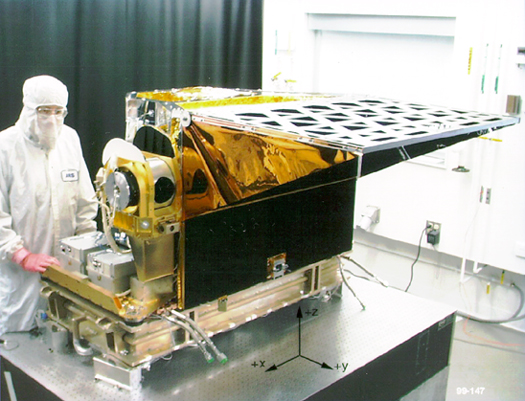Three companies collaborate to pursue cutting edge metamaterial radiometer
05/14/24: Three companies – Atmospheric and Environmental Research (AER), Phoebus Optoelectronics , and BAE Systems, Inc. – are working together to develop a new ultra-compact, infrared instrument for atmospheric sounding of temperature and water vapor.
The instrument, an atmospheric sounder, would replace the bulky, complicated optical systems found in traditional atmospheric sounders with a novel metamaterial spectral filter. Whereas atmospheric sounders today weigh as much as 150 kilograms (330 pounds), a sounder equipped with this metamaterial spectral filter could weigh as little as nine kilograms (20 pounds).
Atmospheric sounders, like NASA’s Atmospheric Infra-Red Sounder (AIRS) instrument, retrieve samples of light vertically through columns of Earth’s atmosphere. These samples, or, “soundings,” help scientists study water vapor, temperature, and other atmospheric features.
The key component of this sensor would be its metamaterial spectral filter. Metamaterial optics, an emerging technology characterized by its ability to manipulate light and radio waves, could drive a new generation of remote sensors, said Igor Bendoym, lead design engineer at Phoebus Optoelectronics.
Bendoym went on to explain that, using the metamaterial filter, scientists could remove most of the conventional optics within the spectrometer while still measuring the key spectral channels that are necessary to perform science.
Mere micrometers in size, this bandpass-filter would block background light from reaching an instrument’s detector. This novel low-mass metamaterial filter selects center wavelengths of light from samples that would otherwise be cluttered with thousands of noise signals.

The Atmospheric Infrared Sounder (AIRS) instrument in the assembly facility, 1999. An atmospheric sounder based on metamaterials would dramatically reduce the size of these instruments. Photo Credit: NASA
“The typical science user only really uses a handful of the collected channels,” said Richard Lynch, senior staff scientist at AER and principal investigator for the project. “Can we fine tune that and get a focused set of 150 to 200 channels that will be useful to the users?”
AER, Phoebus Optoelectronics, and BAE Systems, Inc. will each tackle a different component of the project. Scientist and engineers at AER and Phoebus will collaborate on a novel metamaterial spectral filter, while engineers at BAE will test that filter to ensure its applicability for future instruments.
“Our main purpose in this project is to advance the technology readiness level of this material,” said Michael Gordon, an observational astronomer at BAE, Inc. and infrared instrument specialist.
“The work we’ve been doing thus far is characterizing the filter response, verifying that we can dial in a center wavelength and a bandpass for the multiple channels that are needed for this retrieval, and then also doing environmental testing,” Gordon added.
Designing, manufacturing, and integrating this new metamaterial technology into a novel sensor is a herculean effort, one that might be impossible were it not divided across three businesses and supported by NASA.
NASA’s Instrument Incubation Program (IIP), a part of the agency’s Earth Science Technology Office (ESTO), funds this project.
Gage Taylor, NASA Earth Science Technology Office